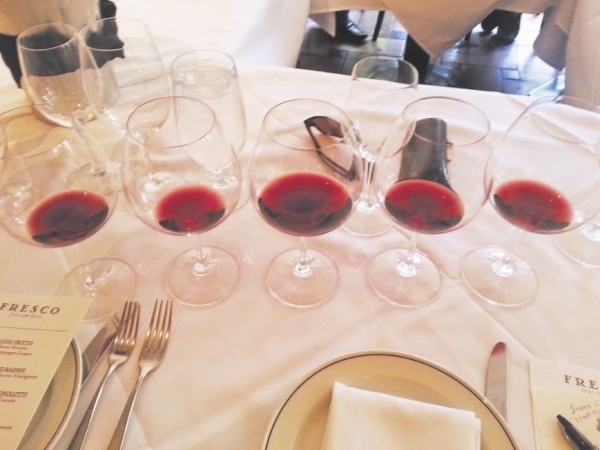
Recently, I found myself at lunch with five wine glasses in front of me. There are definitely days when this job doesn’t suck.
The occasion was a luncheon at Fresco Italian Café, and a visit from Soter Vineyards winemaker James Cahill. Francis Fecteau—owner of Libation Inc., which represents Soter wines in Utah—calls Cahill “one of the great wine minds, from dirt to bottle.” From what I could glean at Fresco, that’s an accurate depiction.
I pass on about 90 percent of the wine tastings and wine dinners I’m invited to, because most are simply tedious, drawn-out affairs where a marketing guy/gal from the winery regales the crowd with tales of how incredible their wines are. But, I was intrigued by this particular tasting, tempted by an unusual format: a vertical tasting of five vintages worth of Soter Vineyards Mineral Springs Ranch Pinot Noir, 2007 to 2011.
Vertical tastings are a rare opportunity to weigh in not only on this vintage versus that, but also to gain some insight into how well certain wines age, and the effect of weather and climate conditions on various vintages. I won’t go into too much technical detail about all that; you can find it in geekier wine columns.
These Pinot Noirs came from Mineral Springs Ranch—located just east of Carlton, in Oregon’s Willamette Valley—where 30 acres of Pinot Noir are planted, along with two acres of Chardonnay. The vineyard features ideal sun exposure, loamy sandstone, siltstone and clay soils, and most of the acreage faces south and southwest. It’s an optimal environment for growing and making optimal Pinot Noir, which is what Soter does best.
We tasted the wines backward, from the most recent 2011 vintage—which hasn’t even been labeled yet—to the 2007, the latter a much-maligned vintage, according to the wine intelligentsia. The 2011 Mineral Springs Ranch Pinot Noir, not surprisingly, is tightly wound, but reminiscent of the classic 2008 vintage. It’s not a fruit-bomb Pinot (none of the Soters are), but well-balanced, and should mature beautifully; it’s got all the right stuff. It will be released this fall, and you should scoop up as much as you can when it shows up. It’ll probably retail for around $40. Thanks to Utah’s small-winery exemption program, you can actually buy Soter wines here cheaper than in Oregon.
Due to climate considerations, the 2010 was a late harvest. Cahill made a point of saying that at Soter, he doesn’t shoot for specific alcohol or sugar levels in his grapes; he just lets the grapes tell him when they’re ready to be picked. Some years, that could be early, in other years, it could be late. The late harvest of 2010 resulted in modest alcohol levels and a very charming, easy-drinking Pinot. By contrast, the 2009 vintage was the result of a long, hot summer and is a blousy wine with higher alcohol content. It’s still a tad hot on the tongue for my taste, but will improve with a couple more years in the bottle.
The 2008 is what Cahill calls Soter’s “Goldilocks vintage.” 2008 is widely considered to be one of Willamette Valley’s greatest vintages, and the toasty, dark fruit and richness of this wine suggests that is true. Cahill refers to 2008 as the year of “no drama” in the vineyards. By contrast, 2007, as mentioned, is widely considered a poor vintage. And yet, the 2007 Mineral Springs Ranch Pinot Noir makes a good case for throwing out vintage charts. This is a gorgeous Pinot Noir and, for my money, the best of the bunch tasted at Fresco. Track a bottle down, if you can.
Twitter: @critic1